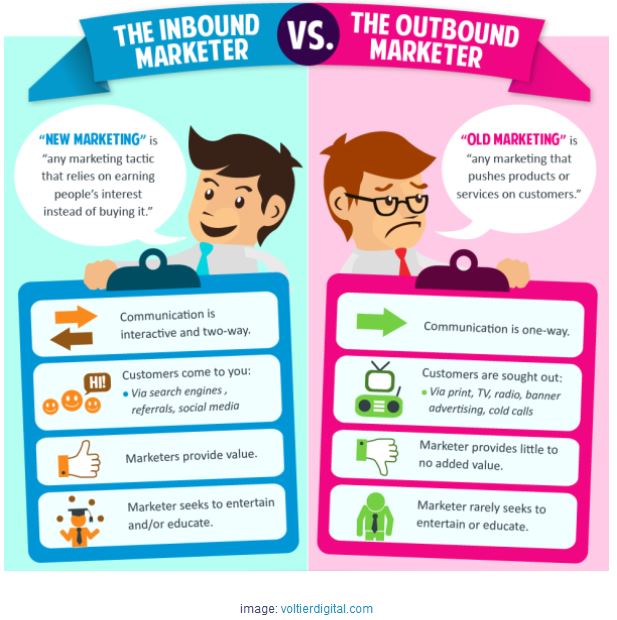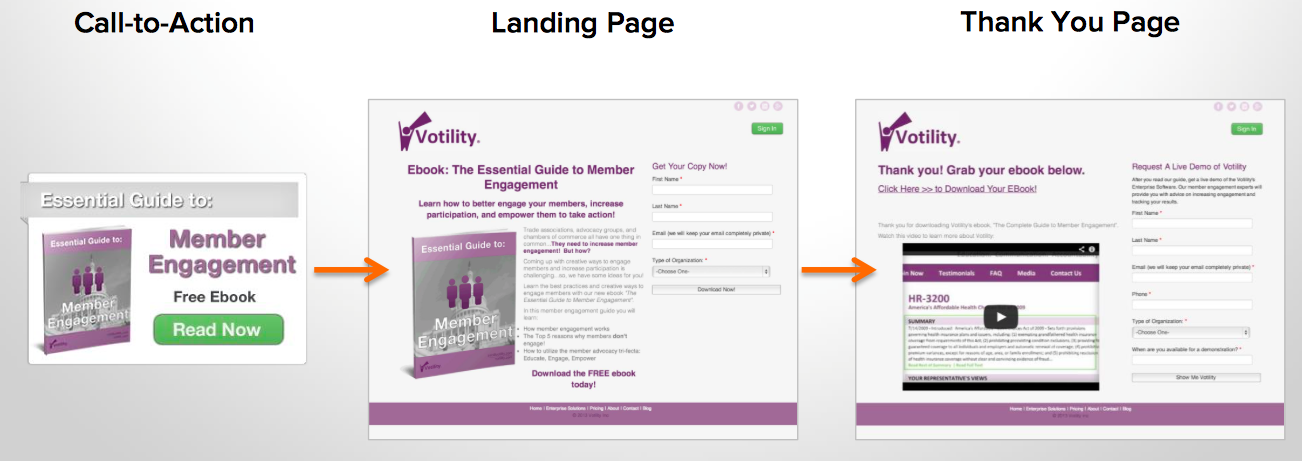Traditional marketing, or outbound marketing, is sometimes referred to as “interruption marketing” because marketers are sending messages out hoping they will resonate with a potential buyer.
Information flows down from the company to consumer and very rarely does it flow up from customer to company.
Outbound marketing includes trade shows, seminars, cold calling, and advertising.
With inbound marketing, instead of putting the messages out there, you put the messages here (on your website or blog) and bring the customers in. To bring customers in, though, you must have highly informative and entertaining content (because you want them to stay!).
Inbound is built to attract, not annoy.
Heavy marketing language is abandoned, and communication is faster (comments, social media) which gives lots of room for the business to build a strong community of visitors and customers.

But before you invest in outbound marketing (because it does take time, money, and patience) you should determine if it is right for your business. Ask yourself these questions (and do further research):
- Are your customers (influenced) online?
- Is the whole team on board?
- Do you have the money to invest in inbound?
- Do you need a miracle overnight?
- Can you provide content that prospects will appreciate?
Smart Bug Media provides an overview of these questions to guide you in determining if inbound marketing is the right solution for your business.
Additionally, before investing in any inbound marketing strategies, make sure your website is up-to-date, fresh and aesthetically relevant and pleasing. Your website should also be optimized for on-page SEO and usability. See this cheat sheet for on-page SEO or visit Hubspot for information on website design, user experience, and usability.
Inbound marketing assists in developing your business as the expert, builds reputation, and builds brand awareness. If done well, it leads customers through the buying process from awareness to action.
Components of Inbound Marketing
- Customer Persona
- Goals
- Editorial Calendar
- Blogging
- Email Automation
- Creating the Offer (or Lead Magnet)
- Creating a Call to Action
- Landing Page Creation
- Exit (or Thank You) Page Creation
- Kickback Email
- Social Media
- Digital Paid Advertising
Let’s discuss these components and how they work together to attract visitors, convert leads, and create customers.
Get to know your customers.
Before you begin building awareness and attracting customers, you should first define your target audience persona. This can be built using market research and using data about existing customers including demographics, behavioral patterns, motivations, and goals. Next, identify your persona’s pain points.
Using this information will help determine what content you develop based upon what is relevant and valuable to your potential customer. This will assist potential leads in getting to know you so they will do business with you and not your competition.
Set realistic and measurable goals.
Before you begin an inbound marketing campaign, or any inbound marketing efforts, you should ask yourself, “What do I want to accomplish with inbound marketing?”.
Gather any current analytics you have on visitor behavior patterns on your website and apply SMART (Specific, Measurable, Attainable, Relevant and Time-bound) goals. If you haven’t already, now is a good time to set up Google Analytics and learn how to use it.
Are you looking to convert visitors to leads? Leads into customers? Customers into repeat customers? Design your offer around your goals.

Commit to your strategy using a editorial calendar.
Using an editorial calendar – and sticking to it – to schedule what content you will create and when to publish/share will keep your efforts consistent and regular. Layout the content or offer with their accompanying call to actions and distribution strategy in the calendar. Plan how you will share (social media, email, digital paid ads) and how you will rework the content into other types of media (video, infographics).
Segment your leads and customize your communications using email automation.
Being able to customize communication based on actions someone takes, such as sign-up for a list, download an e-book, or take a quiz, enables you to stay engaged and visible to today’s buyers. Email automation is also an easy way to nurture your leads throughout the buying process.
Marketing automation software provides data to better understand what buyers’ needs are so you can deliver it at the right time. Some of the options include:
Build out campaign specific landing pages and forms.
Track website visitors.
Capture, score, and nurture your leads.
Automate marketing activities based on marketing triggers.
Analyze and report your results.
Build integrated CRM capabilities.
Not sure of where to start? Entrepreneur reviews 5 of the top email automation softwares for small business.
Quick Tip:
Add social sharing in your emails where the user can share your information and offers with their network.
Create the Offer.
Also known as the lead magnet, the offer should be created with your business persona and goals in mind. Ask yourself, “Is this offer valuable to my target audience?”.
Know your audience, know your audience’s pain points, know how your audience likes to consume information, and know the type of language that resonates with your audience.

Here’s a list of 10 highly effective lead magnets/offers:
Templates (marketing plans, sales letters, infographics)
Surveys, Quizzes, Assessments (business health assessment, health quiz)
Checklists (process oriented, gives how-to information – how to implement something faster, cheaper, better)
Swipe File (collection of your best performing and proven work that can help people be more productive)
Webinars and Video Training
Free Trials
Cheat Sheets (collection of best tools to get the job done)
White Paper, Report, or Case Study (more useful for high end products where companies need help to justify purchase)
Free Consultation
EBook
If you want to build awareness for your brand by increasing website traffic by your ideal customer, share and promote blog posts linking to your site. Those ideal customers will hopefully move on to have an increased interest in your product or service. Offer them more in-depth information such as a white paper, guide, ebook, checklist, or template. If you decide to target visitors who are ready to buy, offer a free trial, consultation, or a live demo. Your offer creates the opportunity to nurture your leads through ongoing giving of value and purpose driven content.
Demonstrate why your brand is better through your offers. Reviews, testimonials, case studies, and webinars showcasing your expertise or product demos can also be effective to convert those leads into buyers.
After establishing authority, ask potential customers to take action.
Quality, relevant, valuable content will set your business up as an expert in your field. Visitors will trust what you have to offer and will be willing to take action. Your call to action (CTA) is usually the way visitors can access the offer.
The CTA should draw visitors in and build awareness about what you can do for them. The positioning and appeal is just as important as the copy used in your CTA. Users will relate to you when you tell them the problem and respect you when you give a solution.
Beware of image clutter. Images help increase curiosity, engage the user, and even induce trust. Images shouldn’t overshadow the CTA but accent it. Be careful not to use too many stock photos which can make you seem disingenuous.
Consider these suggestions when building your CTA:
- Use trigger words with restraint. Don’t use excess emotional appeal.
- Use actionable language, second person verbs.
- Use highly contrasting design to make your CTA pop from the rest of the page.
- Remind user of problem (emotional appeal) and how you will solve it (rational appeal).
- Use only one CTA per page.
- Use a CTA throughout copy and webpages as long as offer is relevant to content on page.
- Place CTA where it is most appropriate to your offer.
- Create short forms – ask only for the info you need.
Share through social media and email marketing activities.
Once users click on your CTA, what’s next?
Once clicking on your CTA, visitors should be led to a landing page. This page should be straightforward – highlight the value and how to it addresses users needs, interests and problems. Use landing pages for campaigns, when sharing content, and for digital paid ads.
Your form should be on this page. Name and email address is usually the minimum. You can ask for user’s business name and business title to better determine users’ needs (which you can then segment this user in your email automation and nurture them better according to their need).
Other items to consider include:
You might want to eliminate the website navigation bar from this page, as you want to limit the number of exits the user has.
Use contrast and complementary colors.
Use social proof – use quotes from users who have taken advantage of the offer and those who have complimented your product/services.
Once users have filled the form out on the landing page, lead them to access the offer.
The thank you page is where you will provide the offer to your user after they have followed through on the CTA. This is also where you will confirm that they have successfully submitted their information and thank them for their engagement.
Explain to your user how to access offer on the thank you page. For example, “click here to download” or inform them that the offer has been emailed to them.
You can reintroduce the navigation bar here because you want the user to visit other aspects of your website. You can also provide a secondary offer or piece of content such as blog links, free consultation offers, or coupons.

Respond automatically with a kick-back email.
The kick-back email is usually automated after the visitor submits the CTA form. This email can deliver a link, or PDF, to the content so they can access it anytime. Just make sure you provide the offer straight away.
As mentioned with the exit page, you can also use your kick-back email to include a second CTA such as a free trial.
Quick Tip: Once you collect email addresses and other info, you can segment according to the buying process and send content that offers value using your email automation software. Remember, create value, do not be sales pitchy.
After launch…What are some other ways to promote your offer?
Social media is a great way to promote your offer and engage users. Brand your piece of content whether it is a blog, related link to the offer, video or infographic. Change your cover photo to match the branding of your offer.
Unsure of which social media platforms are right for your business? Forbes has a great article to address this.
Digital Paid Advertising is another way to amplify your message. Examples of this includes Facebook ads, Instagram ads, LinkedIn sponsored content (great for business to business market).
Website integration using a content library dedicated to content and campaigns, a CTA on the homepage for your offer, links to the offer on other pages such as product pages or blogs that align with the topic.
To wrap up, implementing inbound marketing can be a great solution for your business, if it is right for your business. Remember, inbound marketing is not something you can be halfway committed to – your entire team needs to be supportive of it.
Inbound marketing requires patience, as it might take a couple of months to see a return on investment. It is about giving of unique, quality content that adds something valuable to your users experience.
The above protocols will set you up for success, but do further research to ensure all the right steps and practices are put into place. Happy inbound marketing!



